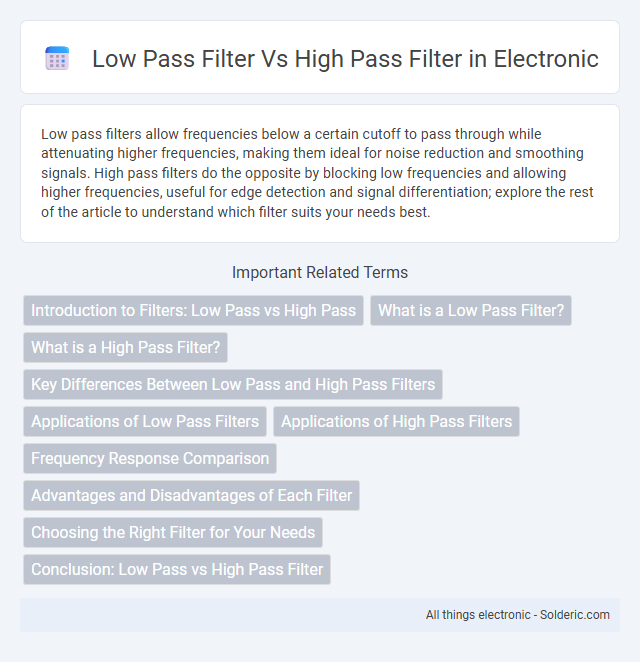Low pass filters allow frequencies below a certain cutoff to pass through while attenuating higher frequencies, making them ideal for noise reduction and smoothing signals. High pass filters do the opposite by blocking low frequencies and allowing higher frequencies, useful for edge detection and signal differentiation; explore the rest of the article to understand which filter suits your needs best.
Comparison Table
| Feature | Low Pass Filter | High Pass Filter |
|---|---|---|
| Function | Allows frequencies below cutoff frequency | Allows frequencies above cutoff frequency |
| Cutoff Frequency | Passes signals below this frequency | Passes signals above this frequency |
| Signal Attenuation | Attenuates high frequencies | Attenuates low frequencies |
| Applications | Audio smoothing, removing high-frequency noise, anti-aliasing | Edge detection in images, removing low-frequency hum, signal differentiation |
| Phase Response | Typically introduces phase shift at cutoff | Phase shift occurs near cutoff frequency |
| Frequency Response | High gain at low frequencies, roll-off after cutoff | Low gain at low frequencies, gain increases after cutoff |
Introduction to Filters: Low Pass vs High Pass
Low pass filters allow signals with frequencies below a defined cutoff to pass while attenuating higher frequencies, effective in smoothing signals and reducing noise. High pass filters permit frequencies above a cutoff point, commonly used to remove DC offset or enhance signal edges in audio and image processing. Understanding their frequency response and application helps optimize signal clarity in communication and electronic systems.
What is a Low Pass Filter?
A low pass filter allows signals with frequencies below a specific cutoff point to pass while attenuating higher frequencies, effectively smoothing or reducing noise in a signal. It is commonly used in audio processing, telecommunications, and signal conditioning to remove unwanted high-frequency components. Understanding how a low pass filter works can help you improve signal clarity and reduce interference in various electronic applications.
What is a High Pass Filter?
A high pass filter allows signals with frequencies higher than a specific cutoff frequency to pass while attenuating frequencies below that threshold. This filter is essential in audio and communication systems to remove low-frequency noise or interference. Your choice between a low pass and high pass filter depends on whether you need to preserve high-frequency details or eliminate unwanted low-frequency components.
Key Differences Between Low Pass and High Pass Filters
Low pass filters allow frequencies below a specific cutoff point to pass while attenuating higher frequencies, making them ideal for removing noise or smoothing signals. High pass filters, conversely, permit frequencies above the cutoff frequency to pass and reduce lower frequency components, useful in applications like edge detection or eliminating DC offsets. The key differences lie in their frequency response characteristics, cutoff frequency orientation, and typical use cases in signal processing.
Applications of Low Pass Filters
Low pass filters are essential in audio processing to remove high-frequency noise, ensuring clearer sound quality. They are widely used in signal conditioning for sensors by smoothing out rapid signal variations and enhancing data accuracy. Your electronic systems benefit from low pass filters when isolating desired low-frequency signals in communication and control applications.
Applications of High Pass Filters
High pass filters are crucial in audio processing to remove low-frequency noise and hum, enhancing clarity in speech and music recordings. They are widely used in radio communications to eliminate interference from lower frequency signals, improving signal quality and transmission efficiency. In image processing, high pass filters emphasize edges and fine details, aiding in feature extraction and object recognition tasks.
Frequency Response Comparison
Low pass filters allow frequencies below a specific cutoff point to pass while attenuating higher frequencies, resulting in a frequency response that gradually decreases beyond the cutoff frequency. High pass filters exhibit the opposite behavior, attenuating frequencies below their cutoff while allowing higher frequencies to pass with minimal loss. The slope steepness and cutoff sharpness in both filters determine how rapidly the transition between passband and stopband occurs, influencing signal clarity and noise reduction.
Advantages and Disadvantages of Each Filter
Low pass filters excel at removing high-frequency noise while preserving low-frequency signals, making them ideal for audio smoothing and signal conditioning, but they can cause signal delay and attenuate sharp transitions. High pass filters effectively eliminate low-frequency hum and DC offset, enhancing signal clarity in applications like audio crossover and vibration analysis, yet they may introduce distortion and reduce signal strength in low-frequency ranges. Understanding these trade-offs helps you choose the appropriate filter for your signal processing needs.
Choosing the Right Filter for Your Needs
Selecting a low pass filter is ideal for applications requiring attenuation of high-frequency noise while preserving lower frequency signals, such as in audio smoothing or sensor data processing. High pass filters excel when you need to eliminate low-frequency interference and emphasize higher frequency components, common in speech processing and edge detection in images. Understanding your signal's frequency characteristics ensures you choose the right filter type to enhance performance and achieve accurate results.
Conclusion: Low Pass vs High Pass Filter
Low pass filters effectively allow frequencies below a specified cutoff to pass while attenuating higher frequencies, making them ideal for reducing high-frequency noise and smoothing signals. High pass filters, in contrast, transmit frequencies above the cutoff, blocking low-frequency components and useful for removing DC offsets and enhancing signal edges. Choosing between low pass and high pass filters depends on the specific frequency range to be preserved or eliminated in applications such as audio processing, communication systems, and signal conditioning.
low pass filter vs high pass filter Infographic

 solderic.com
solderic.com